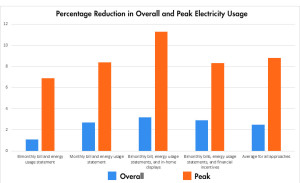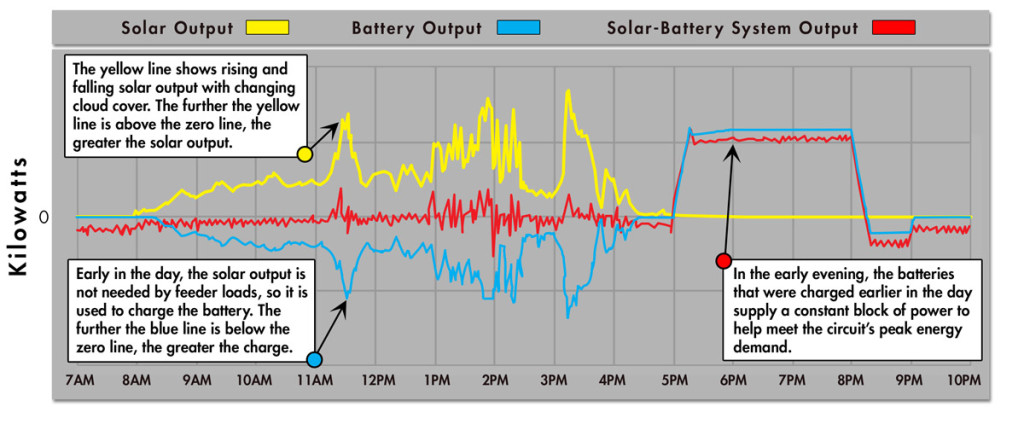Top 8 Takeaways of EPRI’s 7-Year Demonstration Initiative
The Story In Brief
“Smart grid” has a new meaning today, thanks to hundreds of insights from an ambitious research undertaking with 17 utilities. Here’s a selection in areas ranging from energy storage and voltage management to distribution automation and cybersecurity.
In an age of information excess, making lists is an instinctive way to make the overwhelming manageable. From today’s “to-do lists” to corporate mergers, lists provide order and a starting point for more ideas… and more list items.
EPRI researcher Matt Wakefield must have been thinking along these lines in 2008, when he was charged with the monumental task of launching EPRI’s seven-year Smart Grid Demonstration Initiative. The objectives were sweeping and ambitious: launch multiple field projects with utilities, test technologies to integrate distributed energy resources into the grid, and define standards to make all this equipment interoperable.
Wakefield started by engaging potential utility collaborators in conversations to define the initiative’s scope. “We made a list of different types of distributed energy resources to integrate in the demonstrations,” he recalled. “It included items like demand response, energy storage, electric vehicles, and renewables such as solar and wind.”
Fast forward seven years to the completion of the initiative’s 47 demonstration projects with 17 utilities, and a remarkable finding emerged. One of the most customer- and grid-friendly distributed energy resources wasn’t on that original list. Demonstration participants discovered a few years into the initiative that voltage management—optimizing distribution system voltage to reduce energy demand—dramatically improved grid efficiency. “Back in 2008, no one viewed voltage management as an energy resource,” said Wakefield. “Today, it’s seen not only as a resource, but as a big potential energy saver.”
This is just one of hundreds of findings that together have supported the industry’s smart grid progress and advanced its knowledge. And that brings us back to the value of list-making, with eight of the initiative’s major insights.
1. Voltage management can reduce energy use by as much as 4%.
For decades, grid operators have managed distribution system voltage to lower energy losses in power lines, transformers, and end-user devices. Recent advances in sensor technology have enabled more effective voltage management, with potential for much greater energy savings.
Building on previous EPRI research that established the potential energy efficiency benefits of advanced voltage management, the demonstrations tested several voltage management technologies to provide essential details on savings—and where and when they work best. Conservation voltage reduction uses automated controls to reduce voltage delivered to residential appliances and industrial machines during high-demand times. With additional sensing and control technology, this approach yielded 1.5–4% reductions in energy use in various scenarios.
EPRI and its collaborators learned that the benefits of voltage management are greater in feeders serving residential and commercial customers, compared with those serving industrial facilities, as a result of load and feeder characteristics. Also, depending on the region, summer and winter electric peaks can influence the savings. Each utility will need to consider these factors when evaluating benefits and technology costs.

2. Distribution automation can speed outage restoration, but managing the data remains a challenge.
A central element of the smart grid is distribution automation, which allows for real-time, automatic adjustments of distribution system configuration in response to changing electricity supply and demand, outages, faults, and other failures. This self-healing capability involves equipping grid components with intelligent sensors, processing real-time data on grid conditions, and communicating with utility databases.
In 2008, some interoperability standards existed for distribution automation, but quite often components from different manufacturers did not interface seamlessly. Demonstration participants worked to improve these interfaces and interoperability standards.
The efforts paid off. Utilities applying distribution automation achieved faster pinpointing and restoration of outages. For example, 43 self-healing networks deployed in Duke Energy’s Midwest region between 2010 and 2013 performed automatic restoration operations, preventing sustained outage for thousands of customers and saving 9.4 million customer interruption minutes (see chart).
![Duke Energy avoided more customer interruptions as it deployed more distribution automation. [Click to enlarge]](https://eprijournal.com/wp-content/uploads/2015/08/customer-interupt_Graphic-300x171.jpg)
Even with such impressive numbers, EPRI and its partners discovered that integrating the enormous volume of distribution field data from sensors and intelligent devices—and from new and old utility systems—can be messy. A key task ahead is to design communication systems and protocols that can handle the data, including cybersecurity requirements.
3. Advanced metering infrastructure: Benefits extend well beyond meter reading.
In 2008, utilities used customer smart meters mainly for billing. EPRI’s initiative examined new possibilities for smart meters and demonstrated new applications to support utility operations. These included identifying outage locations, managing power quality, measuring voltage for customer solar arrays, supporting conservation voltage reduction and demand management systems, and offering customers time-based electric rates and web portals.
Through these applications, participants took critical steps to define standard communication interfaces and data for advanced metering infrastructure, which supports communication between utilities and customers through smart meters, communications networks, and data management software.
Southern Company demonstrated the use of smart meters for automated monitoring of capacitor banks—grid devices that help control voltage. Meters perform daily health checks on capacitor banks and relay the results to the utility’s meter data management system, which in turn flags malfunctions and alerts field technicians to inspect. The monitoring system identified more than 650 problems in the first six months and allowed for repairs to be made within days, reducing line losses and improving distribution voltage management. The method replaces time-intensive manual monthly readings of existing feeder monitors in substations and annual visual inspections.
4. Solving mysteries: Tools to influence customer energy use have the potential to reduce demand, but understanding customer behavior is not easy.
A key aspect of a smarter grid is engaging smarter customers to reduce electricity use and peak demand. In 2008, industry’s understanding of customer wants and needs—a prerequisite for successful customer engagement—was primarily anecdotal. EPRI’s initiative advanced the statistical science and precision of customer behavior studies. Yet, many aspects of customer behavior remain somewhat mysterious.

Consider the results of the demonstration projects with two utilities: Ireland’s ESB and Illinois’ Commonwealth Edison. ESB offered 3,800 residential customers various combinations of engagement tools: electricity prices that vary by time of day, monthly and bimonthly bills, detailed energy use statements, financial rewards for reducing use, and in-home energy displays. On average, these reduced overall energy use by 2.5% and peak use by 8.8% (see chart). But ESB found no clear electricity price threshold above which customers changed their behavior. Commonwealth Edison’s results were even more baffling: Customers did not alter electricity use in response to peak prices that were more than 15 times their normal rates.
“Customers like the idea of price incentives, but more work is needed to make them effective,” said EPRI’s Gale Horst, who managed the demonstrations. “One problem is that most customers don’t know what a kilowatt-hour is.”
5. Integrated solar-battery systems can provide firm, dispatchable energy.
Much talk in the electric power industry these days focuses on the promise of combining batteries with solar—and with good reason. Batteries can smooth the rapid solar output shifts that can lead to fluctuations in customer service voltage. They can also help reduce a feeder’s load during high-demand periods (a service called peak shaving) and provide firming—the guarantee of constant power output to the electricity market at a certain time. But making this work in practice is still not easy.
A demonstration project at the Public Service Company of New Mexico proved that solar-battery systems can provide these valuable services with the right combination of supporting infrastructure. The utility deployed a 500-kilowatt solar array with a 1-megawatt-hour lead-acid battery system at its Studio Substation distribution feeder, which serves residential, commercial, and industrial customers near Albuquerque. The solar-battery unit is integrated with a cyber-secure communications system that collects a set of data—such as solar array voltage, temperature, and battery output—every second. Supported by these data and modeling predictions of peak load and solar output, the solar-battery unit’s algorithms successfully provided simultaneous voltage smoothing, peak shaving, and firming. It transformed extremely variable solar power into a block of energy that aligned with the utility’s evening peak load (see chart below).
It is an important step in designing solar-battery systems with standard configurations and interfaces that can serve as building blocks for smart grids elsewhere. The goal is to avoid the need to design such units for each local application.
6. Off-the-shelf equipment can serve as building blocks for microgrids.
There is still much to learn about building and reliably operating microgrids—local grids usually connected to the traditional electric grid that disconnect if necessary to operate autonomously. If implemented well, they can provide backup electricity to customers during outages.
At a fire station near a distribution substation, Duke Energy demonstrated that a microgrid can be created from standard utility distribution equipment such as reclosers, transformers, and switches, coupled with a 50-kilowatt solar array and a 500-kilowatt-hour lithium-iron phosphate battery/inverter system. With a few modifications, the devices provided a seamless transition to and from grid connection. Duke determined that the capabilities of standard equipment must be fully investigated and understood in order to build microgrids.

7. Utilities need a coordinated cybersecurity approach for all their interconnected systems.
The grid’s 21st century evolution is being driven by the widespread use and networking of monitoring systems, distribution automation, smart inverters, smart meters, and other intelligent devices. Utilities increasingly depend on data communications and automated control among millions of devices for reliable grid operations, exposing the electric system to potential cybersecurity attacks.
Several utility participants in EPRI’s initiative observed that achieving comprehensive cybersecurity protection for their operations and IT systems is no easy task. One challenge is that multiple systems and operators independently gather and analyze security information from different applications and vendors. The conclusion shared by the participants: Utilities need a coordinated cybersecurity approach that will enable them to support new applications and legacy systems and to comply with regulations and standards.
For its demonstration project, Southern California Edison demonstrated a technology known as Common Cybersecurity Services, with an architecture that supports different devices, current and next-generation networking, and all major communications protocols used in the grid. The technology assigns each grid device a unique key that enables secure communications with its control system. The utility expects that the technology will help to quickly identify cyber events and coordinate many aspects of its security awareness and response.
8. The greatest challenge to achieving a smarter grid: communications.
The demonstrations focused the industry on the paramount importance and challenge of communications technology. “Communications networks need to be as secure, reliable, and robust as the grid itself,” said EPRI’s Matt Wakefield. “This requires strategic infrastructure investments that enable communications across many different utility business units—from grid operations to planning to billing—that have traditionally been siloed.”
Participants experienced many setbacks resulting from communications failures. A common challenge was getting various utility systems to communicate with one another.
In one demonstration, Salt River Project tested a private field area network, a technology that places data systems and processing closer to electric infrastructure and customers and that can accommodate many smart grid applications. The utility found that while such a network requires a large initial investment, it has the potential for long-term payback if used for data-intensive applications.
Key EPRI Technical Experts:
Matt Wakefield, Gale Horst
If you would like to contact the technical staff for more information, send your inquiry to techexpert@eprijournal.com.
See the final report on the Smart Grid Demonstration initiative for more details.



